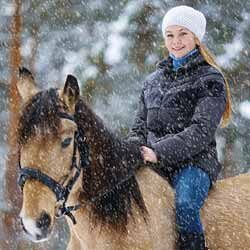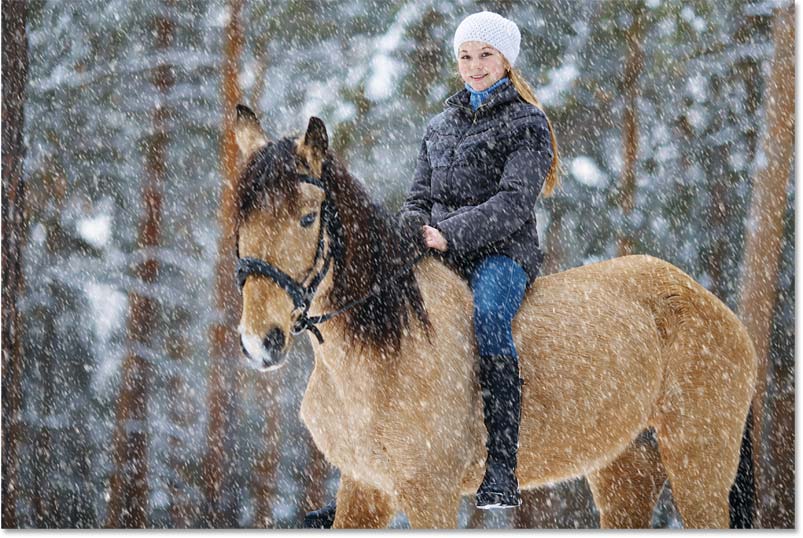
How to Add Falling Snow to Photos with Photoshop
Learn how to add realistic falling snow to your winter photos with Photoshop. A step-by-step tutorial for Photoshop 2024 and earlier.
Download the PDF: Add Falling Snow To Your Photos
Nothing adds to a winter photo like falling snow. And while capturing falling snow with your camera can be tricky, adding the snow later with Photoshop is easy.
In this tutorial, I show you step-by-step how to create your own falling snow effect in Photoshop. And new in this updated version, I also show you how to avoid performance issues with Photoshop when adding the snow to larger images.
Here’s an example of what the final snow effect will look like when we’re done.

Which Photoshop version do I need?
I’m using Photoshop 2024 but any recent version will work.
Let's get started!
The document setup
I’ll use this photo from Adobe Stock but you can easily follow along with your own image.

Related tutorials:
- Make it rain in your photos with Photoshop
- Add stars to your night skies with Photoshop
- Add a rainbow with Photoshop
Step 1: Add a new layer for the snow
In the Layers panel, the photo is on the Background layer.
Add a new blank layer above the image by clicking the Add New Layer icon.

Then double-click on the new layer’s name and rename it Snow
. Press Enter on a Windows PC or Return on a Mac to accept it.

Snow.
Step 2: Fill the layer with black
We need to fill the new layer with black.
So go up to the Edit menu in the Menu Bar and choose Fill.

In the Fill dialog box, set the Contents to Black and click OK.

The image is temporarily hidden from view.

Step 3: Add noise to the layer
To create the snow, start by adding some noise to the layer.
Go up to the Filter menu, choose Noise and then Add Noise.

In the dialog box, select Gaussian and Monochromatic at the bottom.
Then set the Amount of noise to around 25 percent and click OK.

Photoshop fills the layer with noise.

Step 4: Scale the noise
The noise will eventually become our snow effect, but one problem is that it’s too small.
So lets scale the noise by going up to the Edit menu, choosing Transform and then Scale.

In the Options Bar, make sure the link icon between the Width and Height fields is selected.
Then change the Width to 400 percent. The Height will change to 400 percent as well.

Click the check mark in the Options Bar to accept it.

The noise is starting to look more like snow.

Related tutorial: How to use Free Transform in Photoshop
Step 5: Crop away the extra space
But here’s what could cause performance issues with Photoshop if you’re working with a larger image. Since we scaled the width and height of the noise layer by 400 percent, our document size is now that much bigger.
Notice in the Properties panel that my document’s width is now 10800 pixels, and the height is almost 7200 pixels. This could cause problems when we start applying filters to the noise because Photoshop could run out of memory.

The good news is, we don’t need all of that extra space so we can just crop it away.
To do that, go up to the Select menu and choose All.

Then go up to the Image menu and choose Crop.

Go back to the Select menu and choose Deselect.

The document is back to its original size and we can start adding some filters.

Related tutorial: How to crop a single layer in Photoshop
Step 6: Convert the snow layer to a smart object
But before we add any filters, let’s first convert the snow layer into a smart object. That way the filters will be applied as smart filters, which means we can go back and change their settings if we need to.
With the snow layer selected, click the Layers panel menu icon.
Then choose Convert to Smart Object.

A smart object icon appears in the lower right of the thumbnail.
Step 7: Blend the noise with the photo
Still in the Layers panel, blend the noise with the image by changing the blend mode of the smart object from Normal to Screen.

The Screen blend mode hides the black areas on the layer and leaves only the white noise visible.

Related tutorial: How to blend two images in Photoshop
Step 8: Add motion to the snow
To make the snow look like it’s falling, go up to the Filter menu, choose Blur and then Motion Blur.

In the dialog box, set the Angle to the direction you want the snow to be falling from. I’ve set mine to -65 degrees so it’s falling from the upper left.
Then adjust the amount of motion using the Distance slider. Don’t set it too high or the snow will look more like rain. Lower values work better, so I’ll set mine to 10 pixels.
Click OK to close the dialog box.

The Layers panel shows that the Motion Blur filter was applied as a smart filter.
You can double-click on its name to reopen the dialog box if you want to try different settings. But I’m happy with the result.

Also in the Layers panel, we have a new filter mask (the white thumbnail) that’s taking up a lot of space.

We don’t need the filter mask for this effect. So lets delete it by right-clicking on it and choosing Delete Filter Mask.

Step 9: Reduce and brighten the snow
Next we’ll reduce the amount of snow and brighten the snow at the same time.
Go up to the Image menu, choose Adjustments and then Levels.

To reduce the number of snowflakes, click on the black point slider below the left side of the histogram and begin dragging it to the right.
As you drag, you’ll see the darker snowflakes begin to disappear, leaving only the brighter flakes visible.

Then to brighten the remaining snowflakes, click on the white point slider below the right side of the histogram and drag it to the left.
When you’re done, click OK to close the dialog box.

Back in the Layers panel, notice that even though Levels is an image adjustment, not a filter, Photoshop still applied it as a smart filter which means that you can double-click on its name to reopen the dialog box and change the settings if needed.

Step 10: Duplicate the snow layer
At this point, the initial snow effect is done. But let’s add some depth to it by adding a second snow layer, this time with larger flakes so they’ll look like they were closer to the camera.
In the Layers panel, make a copy of the Snow
smart object by dragging it down onto the Add New Layer icon.

The copy appears above the original, along with a copy of our smart filters so we don’t need to reapply them.

Step 11: Rotate the second snow layer
Let’s rotate the copy so the new snowflakes are not just sitting on top of the originals.
Go up to the Edit menu, down to Transform and choose Rotate 180 degrees.

Rotating the copy doubles the amount of falling snow.

Step 12: Make the snowflakes larger with Crystallize
To make these snowflakes larger than the originals, go up to the Filter menu, down to Pixelate and choose Crystallize.

Increase the Cell Size at the bottom to somewhere between 10 and 20. I’ll go with 15.
Then click OK to close the dialog box.

If the flakes look too big, or not big enough, just double-click on the Crystallize smart filter in the Layers panel and try a different setting.

Step 13: Add motion to the snowflakes
The only problem with the larger flakes is that they don’t have any motion applied.
So go back to the Filter menu, back to Blur and once again choose Motion Blur.

Leave the Angle the same so the snow is falling in the same direction. But because these flakes are bigger, increase the Distance to around 20 pixels. Then click OK.

Step 14: Reduce and brighten the larger snowflakes
Finally, let’s reduce and brighten these larger flakes by adding one more Levels adjustment.
Go back to the Image menu, back to Adjustments and choose Levels.

Then just like we did before, drag the black point slider to the right to reduce the number of flakes, and drag the white point slider to the left to brighten the ones that remain.
Then click OK to close the dialog box.

And with that, we have our completed falling snow effect.

And there we have it! That’s how to add falling snow to your winter photos with Photoshop.
Related tutorials:
- Make it rain in your photos with Photoshop
- Add stars to your night sky with Photoshop
- Add a rainbow with Photoshop
Don't forget, all of my Photoshop tutorials are now available to download as PDFs!